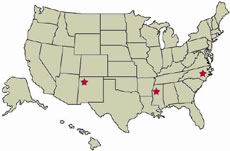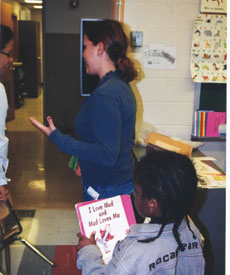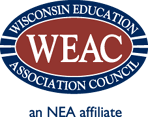Life Lessons
By Heidi Olsen
 |
Courtesy of Heidi Olsen |
| Click on the map to read Teach For America letters. |
Teaching wasn’t as easy as Lori Lukowski thought
it would be. Up by 6 in the morning and in the classroom by 7, Lukowski’s
daily alarm is a cruel wake-up call from her university days of sleeping
in and sitting in large lecture halls. Now she is the one at the front
of the room, working to impart knowledge and inspiration as a teacher
in a low-income school in the Bronx. As a part of the Teach For America
program that brings college graduates to at-risk city schools, Lukowski
faces realities she never encountered as a student at UW-Madison.
“Teaching is harder than I ever, ever, ever imagined it would
be,” Lukowski says. “I thought it would be easy …
summers off, etc., but it’s so not true.”
Teach For America, a program dedicated to eliminating educational inequality
in the country, provides recent graduates with an alternative chance
to earn some income and gain valuable life experiences. A starting salary
at a Teach For America school can range from $20,000 in some districts
to $39,000 in places like New York City where masters degrees are required.
With unemployment rates up nationwide and recent college graduates still
on the job hunt, young adults are looking for new opportunities to get
through the everlasting months of a tough job market. Some graduates
are looking into programs such as Teach For America to fill the time
during the uncertain economy.
However, Lukowski, who graduated in 2003, urges students not to become
involved in the program for the wrong reasons because it’s not
as easy as one may think. “It was the most amazing and most difficult
time in my life,” Lukowski says. “[Teach For America] was
upfront about everything, but I never worked so hard in my life.”
Since 2000, unemployment in men between the ages of 20 and 25 has increased
from 3.2 to 6.1 percent, while unemployment in women between the ages
of 20 and 25 has increased from 3.7 to 5.2 percent. In addition, over
the past two or three years, the number of employers participating in
campus job fairs has dropped 30 to 40 percent. This has led some college
graduates to consider other opportunities.
This year the program has seen its applications for positions rise 13
percent from last year’s applications. For a total of 2,300 slots,
about 15,700 candidates applied for the 2003-04 school year.
Yet the economy cannot be the only factor that contributes to this rise
in applications. Student interest in the state of the world around them
also drives them to give of their time and talents.
Joel Giffin, a campaign coordinator for Teach For America, says the
Madison student community has a strong awareness of world affairs. He
says students who get involved know that programs such as Teach For
America will be beneficial to their future plans. He explains that students
on this campus know that changes need to be made to provide equal opportunity
to all students. “By getting involved in Teach For America, they
will also help themselves,” Giffin says.
However, Giffin stresses that students should not join Teach For America
just to kill time while the job market is poor. “It is an extremely
intense experience, and it is a lot of hard work,” Giffin says.
“Corps members are forced to step outside their comfort zone.”
 |
Courtesy of Anne Kubena |
UW senior Jana Weiland and student |
Senior Jana Weiland has been interested in the program
since she started working with an after-school Safe Haven program
for
elementary-age children two years ago. “It’s frustrating
to know that people want to become involved in the program now that
the economy is poor and not allowing space for the people who are really
dedicated,” Weiland says. “It’s not fair to the
kids and unfair to those candidates who really want to make a difference.”
The program has always been extremely competitive, but
with increasing applications, it makes it even harder for people to
become involved. The mean grade point average of this year’s volunteers
is a 3.5, whereas the minimum to apply is a 2.5. 92 percent of the volunteers
held leadership roles in organizations such as student government, church
groups and fraternities. Giffin describes the perfect candidate as having
a “strong record of outstanding achievements through college;
as having been dedicated to the success of a cause on campus, whether
that be through a student organization, a job or volunteering; and having
a strong sense of personal responsibility.”
All majors are accepted, but there has been an increasing demand for
math, science and engineering due to the lack of math and science teachers
in the public school system. Giffin ensures that getting involved in
the program will provide strong leadership skills that will set graduates
apart from other applicants for jobs or graduate schools. “They
will see that there is something special about you,” Griffin says.
The Experience
Before Lukowski entered her freshman year at UW-Madison, she never even
thought about participating in Teach For America. “A man came
to talk to my senior class in high school about the program,”
Lukowski says. “I thought it sounded a little crazy.”
Things changed for Lukowski after she took several courses dealing with
mass media and minorities. “[They] opened my eyes to the disparities
prevalent in education and it made me realize that where you are born
dictates your opportunities,” Lukowski says. “I was born
right outside of Milwaukee in a suburb and both parents worked, but
they were home for me after school.”
After attending an informational meeting, Lukowski labored through an
extensive five-part online application. The first four sections included
information about her personal and academic life, while the last section
required a letter of intent, résumé and personal essay.
An intense recommendation form also had to be completed and sent to
the admissions office. Lukowski had to attend an all-day session at
the Memorial Union at the UW-Madison campus with 13 other potential
candidates and teach a five-minute lesson. She also had to endure a
rigorous interview process and submit two written responses based on
several articles she had to read.
Lukowski was one of 42 volunteers admitted into the program from UW-Madison
this year. Teach For America placed her in the New York program in the
Bronx where she worked with third-graders as part of her training. “I
was involved in classes half the day and then workshops at night,”
Lukowski says. “They actually teach you how to teach.”
Once training ended, she began teaching at another Bronx elementary
school. She now works with 25 kindergartners at Public School 8, an
hour-long commute from her house. It requires Lukowski to take a bus
and two subways about seven stops.
The New York program targets schools based on the percentage of students
that qualify for free and reduced-price lunches. As of this year, more
than 80 percent of children in New York City qualify for this program,
compared to the 64 percent of children who qualify for the Atlanta program.
Beyond coping with the intimidation Lukowski felt when she entered a
city she had only heard about in the news, she soon found the biggest
challenge was how to provide these children with an education. “I
thought it would be hard working with the poverty and race issues, but
the hardest challenge is really teaching,” Lukowski says. “College
was a cake walk compared to this.”
Lukowski has also been able to benefit from her new location. “Last
weekend, I took a row boat through Central Park,” she says. “It’s
definitely the best part of being in the city so far.”
In addition, Lukowski enjoys working at the school to which she was
assigned. While good resources are hard to find in some inner-city schools,
Lukowski’s has the essential books, materials and people to make
the experience more beneficial for the children. “I have a mentor
who will come in and tell me what to improve, which is amazing,”
Lukowski says. “Without her, the students would suffer.”
While Lukowski still plans on attending law school after the program,
her focus has shifted. “I want to stay involved in education,
but I’m not sure how,” she says. “I need to figure
out where I’m going to be most effective. It might not be in the
classroom, but it might be getting involved in educational policy or
public policy.”
Lukowski advises that potential candidates do their research to make
sure that their motives for applying match the program’s mission.
Lukowski stresses that if students plan to use Teach For America as
a stepping-stone or to bide their time in a weak economy, they should
reconsider. “You really have to believe that there is an education
gap and that the way to solve it is to have young leaders in the classroom,”
Lukowski states. “Without that, you won’t make it.”
For more information about this article visit the following sites:
Teach
For America: This site contains further information about Teach
For America including a online application and real stories from Corp
members.
UW-Madison
Student Organization Office: This site has further information on
the UW-Madison chapter of Teach for America.
U.S. Department
of Labor Bureau of Labor Statistics: This site contains reports
on unemployment rates and occupational outlook.
|








